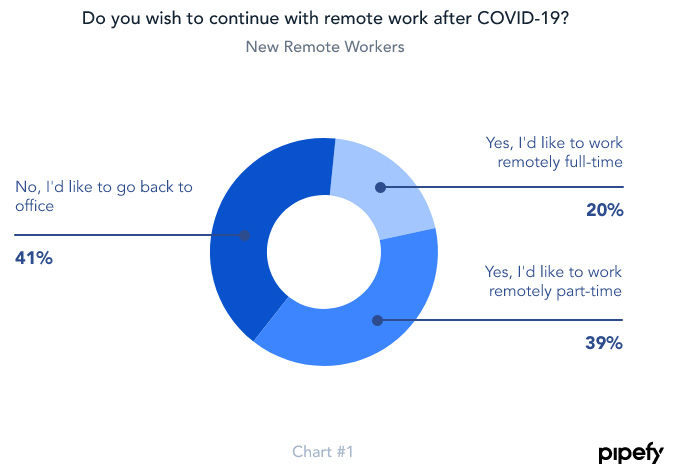As the pandemic continues, working from home has gone from temporary novelty to a (sort of) new normal. People have figured out Zoom and worked through home WiFi issues. We’ve made the transition to thinking of “commuting” as going to another room or even just shifting our mental focus rather than a physical journey.
So, now that we are a few months into this new coronavirus-induced reality, how do professionals feel about their work from home (WFH) arrangements? Pipefy recently surveyed more than 400 employees of midsized and large firms to find out. As an interesting twist, they contrasted responses from seasoned remote workers to those new to WFH due to COVID-19.
While many of the findings weren’t surprising (employees feel they less visibility into the status of various projects when working from home, and they miss the spontaneous, casual conversations in their office work spaces), a few were. Here are half a dozen of the more noteworthy conclusions.
People Want to Go Back to the Office
 Respondents were more than twice as likely (41% to 20%) to say they’d like to go back to the office rather than work remotely full time.
Respondents were more than twice as likely (41% to 20%) to say they’d like to go back to the office rather than work remotely full time.
Four-fifths of respondents prefer working at the office full or part time rather than working at home exclusively.
(But though they’d like to return to the office, employees aren’t necessarily in a big hurry to do so. According to another recent study by TrustRadius, 57% of tech workers said they’d be unwilling to go back until September or later.)
Mental Health is a Big Issue
Of those who said they’d like to return to the workplace, large percentages said (not surprisingly) that they are most satisfied with the (increased) family time, flexibility, and work hours of WFH.
However, less than half (45%) responded that they are most satisfied with the mental health impacts of working from home, while an almost equal share (41%) said they were least satisfied with this aspect.
Frustration and Burnout Vary Widely
On a related note, new remote workers were four times as likely (32% vs. 8%) as experienced remote workers to say they “are frustrated (with) WFH because they’re burning out.”
Distractions Aren’t the Only Challenge
New remote workers who want to return to the office name distractions (63%) as their biggest challenge with WFH. No surprise there.

However, distractions were far from the only significant challenge. Nearly a third (31%) of these respondents said collaboration and communication issues were among their biggest challenges. 28% cited a lack of suitable home office space. And one out of eight (13%) remain frustrated with IT issues.
Fido and Fluffy Are Among Biggest Distractions
Not surprisingly, childcare and family topped the list of biggest distractions, for both new and experienced remote workers.
Among those new to the WFH world, 39% identified household chores as another of their biggest distractions, while 35% said the same of TV. Notably, almost one-third (31%) of new remote workers cited pets / petcare as a major distraction.
The Impact on Productivity is Unclear
Somewhat surprisingly, only 48% of new remote workers said they were more productive working from home. (The lack of wasted time commuting alone should be a significant productivity boost.)
Even more surprisingly though, only 55% of experienced remote workers said WFH made them more productive.
The conclusion? A mix of time in the office and working remotely is probably the best approach for many roles.
This infographic illustrates more results from the Pipefy study.

![]()
The post Six Surprising Research Findings About Working from Home [Infographic] appeared first on B2B Marketing Blog | Webbiquity.
